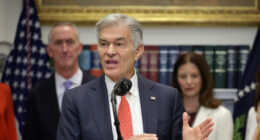Share this @internewscast.com

The Bureau of Labor Statistics is set to release a critical inflation report later this month, even amidst a government shutdown that has left economists without essential data at a pivotal time for the economy.
September’s Consumer Price Index data will now be published on Oct. 24, nine days after its original planned release date, according to the BLS.
This report is crucial for policymakers as they decide on future interest rates. It’s particularly significant now because this data will affect the Social Security cost-of-living adjustment, or COLA, for 2026.
That’s because the annual Social Security benefit bump is tied to the average inflation data for July, August and September.
According to a recent forecast by the Senior Citizens League, the COLA is expected to be 2.7% for 2026, which is a slight increase from this year’s 2.5%. However, unexpected changes in September’s figures could alter this projection.
Under normal circumstances, the COLA would have been announced this week, but it’s been delayed since the shutdown closed the BLS.
The agency is now bringing back workers to compile the September report, ‘s partner The Hill reported.
The BLS stated that the forthcoming CPI release would enable the Social Security Administration to adhere to legal deadlines to “ensure accurate and timely payment of benefits,” though other reports remain delayed.
“No other releases will be rescheduled or produced until the resumption of regular government services,” the agency said Friday.
For instance, the government’s September jobs report hasn’t been published yet, leaving economists to depend on private sector data to evaluate the health of the economy.
House Speaker Mike Johnson, R-La., indicated on Monday that the shutdown might become the longest in history, stating he “won’t negotiate” with Democrats until they halt their health care demands and resume operations.
If the shutdown drags on and official economic data remains scarce, it could complicate the Federal Reserve’s upcoming interest rate decision.
Officials cut rates for the first time this year in September amid rising labor market risks, but it’s difficult to assess how those risks have evolved without new data. Inflation remains above the Fed’s 2% target, and the full impact of President Donald Trump’s tariffs is still unclear.
Even so, markets widely expect another rate cut this month, with traders pricing in a 99% chance of a quarter-point reduction, according to the CME FedWatch tool.












